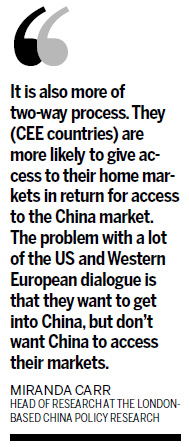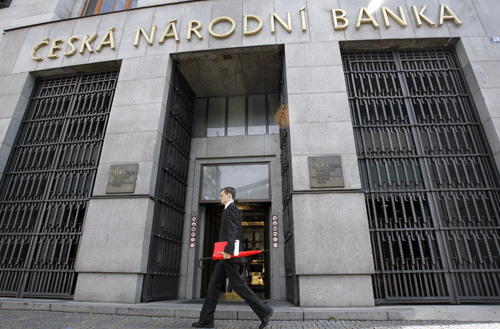Old friends turning into new markets
Updated: 2011-12-03 08:03
By Andrew Moody (China Daily)
|
|||||||||
|
A visitor passes the Czech National Bank building in Prague. The importance of the relationship between China and Central and Eastern European (CEE) countries was highlighted when senior trade and political figures descended on the Czech National Bank building for the second China Investment Forum in November. Adam Berry / Bloomberg News |

The countries of Central and Eastern Europe are rapidly becoming major trading partners with China
PRAGUE - The medieval splendor of Prague seems far removed from the skyscrapers of China's modern urban metropolises of Shanghai and Shenzhen - but there is an increasingly close and important trading relationship between the Central and Eastern European (CEE) countries and the world's second-largest economy.
Disagreements over the value of the yuan might overshadow China's trade relationship with the United States and Western Europe, but currently trade between CEE countries and China stands at more than 10 times the level in 2001 and has grown at 32 percent annually over the past 10 years.
In 2010 alone, trade increased by 34.1 percent to $41.1 billion, according to figures from the Chinese Ministry of Commerce.
The importance of the relationship was highlighted as senior trade and political figures from China and CEE countries descended on the Czech National Bank building at Senovazne Square in the capital of the Czech Republic for the second China Investment Forum in November.
Peter Hyl, the charismatic 28-year-old executive chairman of the forum, said the Chinese and CEE economies have much in common, as they are both suppliers of goods and services to Western markets.
"China can be characterized as a manufacturing base supplying Western economies and that is the same with large parts of Central and Eastern Europe. The structure of the economies is very similar," he said.
The trade relationship between China and the CEE nations came into focus in June when Premier Wen Jiabao visited Hungary, where he announced 400 million euros ($539 million) of financial support for a European logistics base, including an airfield with road access, which would be a hub for Chinese goods entering Europe.
Other major Chinese investments in the region include the battery and electric auto manufacturer BYD Automobile Co Ltd, which has a major battery plant in Hungary.
Great Wall Motor Co Ltd is to open a new factory in Bulgaria at the end of the year, where it will assemble 50,000 cars a year.
CEE companies are also making major investments in China. Skoda Auto, one of the Czech Republic's most iconic brands and a general partner of the forum, began manufacturing cars in Shanghai in 2007 and expects to produce more than 200,000 this year.
PPF Group, the largest financial and investment company in CEE and whose majority shareholder is the Czech billionaire Petr Kellner, is making big inroads in China's consumer finance market with its Home Credit brand and has already issued 1.3 million loans.
Ren Hongbin, vice-president of the Chinese Academy of International Trade and Economic Cooperation under the Ministry of Commerce, a keynote speaker at the forum, said it is easier for Chinese companies to do business in CEE countries than in the European Union, where the market is often more difficult to access.
"The European Union is very conservative and often a closed circle with most of its imports and exports being within its borders," he said.
Ren said the close relationship with CEE countries is a long-standing one, beginning when a large number of them were among the first to recognize the People's Republic of China in 1949.
"Because this part of Europe established diplomatic relations with China 62 years ago, we have a very good background foundation."
Miranda Carr, head of research at the London-based China Policy Research, an investment research company that has offices in Beijing, said the Chinese often feel more comfortable dealing with companies from CEE countries.
She said they are often more collaborative in their approach and less likely to give lectures on how to conduct business than their US and Western European counterparts
"Instead of Western companies going into China and saying 'we want to invest and this is how we want to do it', Central and Eastern European companies have more of an attitude of wanting to work together.
"It is also more of two-way process. They are more likely to give access to their home markets in return for access to the China market. The problem with a lot of the US and Western European dialogue is that they want to get into China, but don't want China to access their markets."
Countries such as Hungary have very close investment and trade ties with China. Hungary was one of the few European countries to offer no-visa access to Chinese citizens in the early 1990s and there are now 50,000 Chinese citizens in Budapest alone.
Chinese foreign direct investment in Hungary was $370.1 million in 2010, up from just $400,000 in 2004, according to the Chinese Ministry of Commerce.
Some 15 percent of Hungary's own outbound investment is also in China, more than any other CEE country, according to the United Nations Conference on Trade and Development.
China's outbound investment in other CEE countries is still relatively low and in the Czech Republic amounted to just $2.1 million in 2010. Some believe there is a fear of Chinese investment in a number of CEE countries, whereas US and Western European investment is more warmly welcomed.
Michal Mejstrik, chairman of the International Chamber of Commerce in the Czech Republic, insists this is not the case.
"The reason why the Chinese FDI figures are low is that many of the Czech State-owned industries were privatized in the early 1990s when the Chinese had no money," he said. "Let me talk of the assets I am now responsible for on behalf of the government. Czech Airlines is on the list. I can say that Chinese investors are welcome."
Kamil Blazek, chairman of the steering committee of the Prague-based Association for Foreign Investment, believes there is a certain complacency in the Czech Republic.
"I think there is a sense that China needs the Czech Republic as much as the Czech Republic needs China. The reality, of course, is that China can live without the Czech Republic. It is a giant market," he said.
Even members of the Chinese delegation attending the Prague forum had difficulties with their visas and found themselves spending an afternoon at the police station to obtain extensions.
Despite being from the Chinese Ministry of Commerce, Ren was one of those who was held up.
"The ease with which you can obtain a visa is the business card of a particular country. When I worked at the Chinese embassy in the Czech Republic there were several cases of businessmen from China getting similar treatment," he recalled.
"I remember one case where some very big bosses from China were not prepared to put up with it and just turned back and returned to China."
Milan Hovorka, vice-minister of industry and trade of the Czech Republic, was apologetic in a meeting hall in the impressive trade ministry building in central Prague.
"I don't have any particular information about this case, but there must be some misunderstanding. We would like to improve our visa system and be more welcoming," he said.
According to Hovorka, one of the problems was the Schengen visa system, under which countries such as the Czech Republic are seen as a weak link in allowing people gaining entry into Western Europe.
"We have set up a special department that can help business people and companies from China obtain a fast visa," he said.
Most CEE countries trading with China have huge trade deficits. Poland, one of the major countries in the region, imported $7.49 billion of goods from China, five times the level of its exports of $1.51 billion to the country in 2009, according to China's General Administration of Customs.
It is a familiar pattern across the region. Bulgaria's imports from China, worth $600 million, were more than four times its exports the other way.
Hungary's imports from China were $5.34 billion, more than three times its exports of $1.47 billion to China. As for the Czech Republic, its imports of $5.02 billion were fourfold its exports of $1.13 billion.
The only European country to have a trade surplus with China was Germany, with China importing $55.7 billion of goods and exporting just $49.9 billion.
Maris Elerts, deputy director of the Investment and Development Agency, based in Riga, said the problem for small countries such as Latvia is having a sufficient trade volume to be of interest to China.
It exported just 25 million euros of mainly scrap copper and aluminum to China, as well as timber products, and imported goods worth 300 million euros, giving it a significant trade deficit.
"The issue is that entrepreneurs from China want large volumes and companies in Latvia - because of the size of the economy - cannot supply these.
"This sometimes means that entrepreneurs on our side often have to cooperate with Lithuania, Estonia and even Poland to put together the volumes."
Elerts is particularly keen for Chinese companies to consider investing in warehousing and distribution centers and even building port terminals in Riga. Currently, Chinese investment in the country is less than 1 million euros, mainly made up of those running Chinese restaurants.
"There is land available they could rent for 50 years to build terminals. Latvia has the potential to be a major distribution hub for China. It takes just 14 days by rail to transport goods via Kazakhstan to Riga," he added.
China Daily
(China Daily 12/03/2011 page10)












